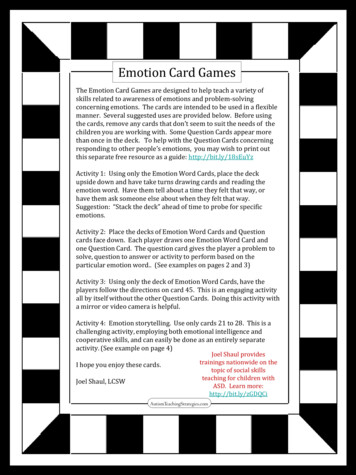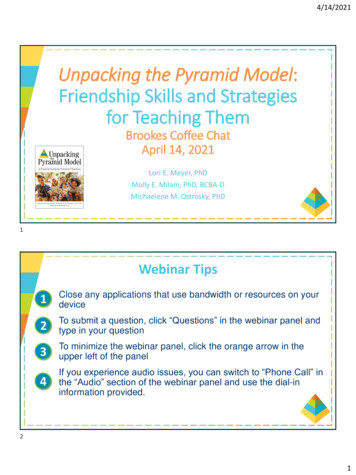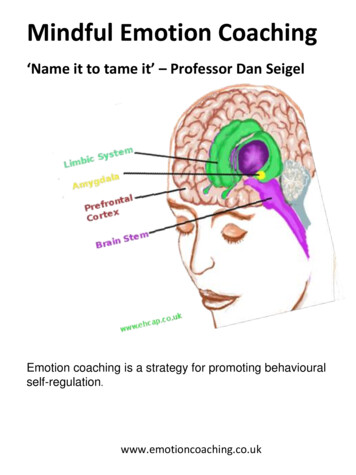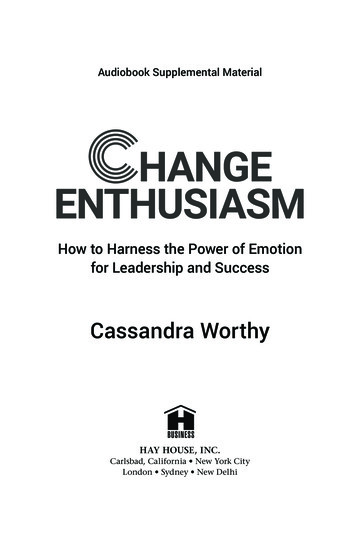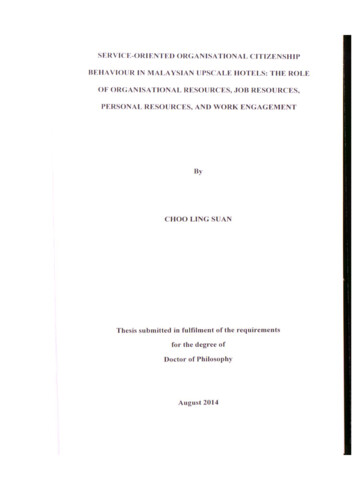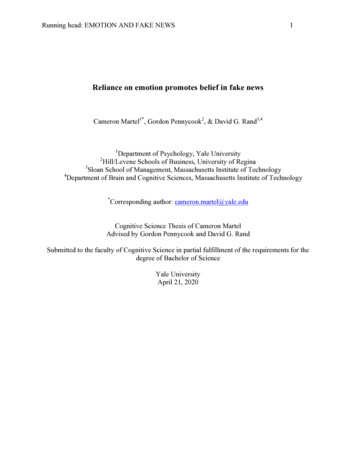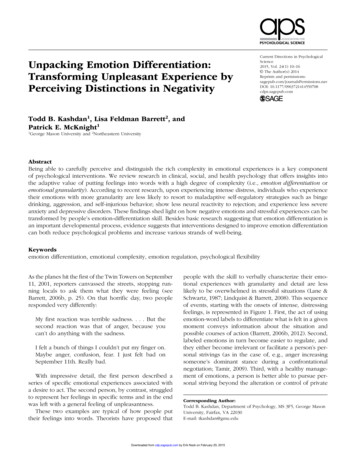
Transcription
550708Kashdan et al.Transforming Unpleasant ExperienceUnpacking Emotion Differentiation:Transforming Unpleasant Experience byPerceiving Distinctions in NegativityCurrent Directions in PsychologicalScience2015, Vol. 24(1) 10 –16 The Author(s) 2014Reprints and : 10.1177/0963721414550708cdps.sagepub.comTodd B. Kashdan1, Lisa Feldman Barrett2, andPatrick E. McKnight11George Mason University and 2Northeastern UniversityAbstractBeing able to carefully perceive and distinguish the rich complexity in emotional experiences is a key componentof psychological interventions. We review research in clinical, social, and health psychology that offers insights intothe adaptive value of putting feelings into words with a high degree of complexity (i.e., emotion differentiation oremotional granularity). According to recent research, upon experiencing intense distress, individuals who experiencetheir emotions with more granularity are less likely to resort to maladaptive self-regulatory strategies such as bingedrinking, aggression, and self-injurious behavior; show less neural reactivity to rejection; and experience less severeanxiety and depressive disorders. These findings shed light on how negative emotions and stressful experiences can betransformed by people’s emotion-differentiation skill. Besides basic research suggesting that emotion differentiation isan important developmental process, evidence suggests that interventions designed to improve emotion differentiationcan both reduce psychological problems and increase various strands of well-being.Keywordsemotion differentiation, emotional complexity, emotion regulation, psychological flexibilityAs the planes hit the first of the Twin Towers on September11, 2001, reporters canvassed the streets, stopping running locals to ask them what they were feeling (seeBarrett, 2006b, p. 25). On that horrific day, two peopleresponded very differently:My first reaction was terrible sadness. . . . But thesecond reaction was that of anger, because youcan’t do anything with the sadness.I felt a bunch of things I couldn’t put my finger on.Maybe anger, confusion, fear. I just felt bad onSeptember 11th. Really bad.With impressive detail, the first person described aseries of specific emotional experiences associated witha desire to act. The second person, by contrast, struggledto represent her feelings in specific terms and in the endwas left with a general feeling of unpleasantness.These two examples are typical of how people puttheir feelings into words. Theorists have proposed thatpeople with the skill to verbally characterize their emotional experiences with granularity and detail are lesslikely to be overwhelmed in stressful situations (Lane &Schwartz, 1987; Lindquist & Barrett, 2008). This sequenceof events, starting with the onsets of intense, distressingfeelings, is represented in Figure 1. First, the act of usingemotion-word labels to differentiate what is felt in a givenmoment conveys information about the situation andpossible courses of action (Barrett, 2006b, 2012). Second,labeled emotions in turn become easier to regulate, andthey either become irrelevant or facilitate a person’s personal strivings (as in the case of, e.g., anger increasingsomeone’s dominant stance during a confrontationalnegotiation; Tamir, 2009). Third, with a healthy management of emotions, a person is better able to pursue personal striving beyond the alteration or control of privateCorresponding Author:Todd B. Kashdan, Department of Psychology, MS 3F5, George MasonUniversity, Fairfax, VA 22030E-mail: tkashdan@gmu.eduDownloaded from cdp.sagepub.com by Erik Nook on February 20, 2015
Transforming Unpleasant Experience11IntenseNegativeEmotionsProgress inValuedStrivings andGreater WellBeingMoveTowardValuedStrivingsDifferentiateand round) orFacilitator ofStrivingsFig. 1. Emotion differentiation as a gateway to greater well-being in a sequence ofevents instigated by the presence of intense negative emotions and the ability to effectively label experiences with emotion-word labels.mental events (Kashdan, Breen, & Julian, 2010). When aperson struggles to manage intense distress, life aimssuch as trying to be a compassionate parent, becomingphysically fit, or writing a book about zombies with ahistorical approach become secondary to emotional-regulation efforts. Subsequently, those who struggle withemotion differentiation and regulation may be prone tounhealthy, unfocused responses to feel better that are notwell tailored to the situation—such as binge drinking orphysical aggression.Thinking Seriously AboutMeasurementA number of different psychological constructs describethe ability to precisely represent affective changes as differentiated emotional experiences associated with healthyemotion regulation. These are presented in Table 1. Oneimportant distinction has to do with how the constructsare measured. There is a trait measure of emotion differentiation for which respondents are asked to characterize their experiences in global, retrospective terms(rating items such as “I am aware of the different nuancesor subtleties of a given emotion” on a 7-point scale fromdoes not describe me very well to describes me very well;Kang & Shaver, 2004). These types of retrospectiveresponses require people to retrieve and aggregateresponses from multiple situations and tend to reflectpeople’s beliefs about themselves rather than provide anaccurate representation of momentary emotional experiences (see Robinson & Clore, 2002, for problems withretrospective self-reports).In our view, because emotion differentiation is a skill,it should be measured behaviorally. This requires observing how people report their emotional experiences on amoment-to-moment basis. An experience-samplingapproach allows scientists to construct a performancebased measure of emotional differentiation by takingintensive repeated measurements over a longitudinalperiod and observing the patterns in people’s momentarysubjective reports (Lindquist & Barrett, 2008). Peoplehigh in differentiation report more detailed emotionalexperiences on different occasions and use differentadjectives to represent distinct kinds of experiences (e.g.,distinguishing the presence and intensity of anger, nervousness, embarrassment, guilt, and regret). People lowin differentiation use the same set of adjectives to reporttheir experiences but use them to represent only a fewgeneral feeling states. For example, they might use wordslike angry, sad, and afraid to communicate an unpleasant experience and words like excited, happy, and calmto describe a pleasant experience.Downloaded from cdp.sagepub.com by Erik Nook on February 20, 2015
Kashdan et al.12Table 1. Emotion-Complexity Terminology and l hymiaDefinitionMeasurementThe skill of labeling experience with a high degreeEmpirically derived indices computed fromof specificity—sometimes defined as the skillintensively repeated measurements of momentaryof “identifying” or “recognizing” emotions withself-reports across situations and instances; thereaccuracy (this assumes that emotional reports have a is also a global trait self-report measure (Kang &clear, objective criterion against which accuracy canShaver, 2004).be compared, but see Barrett, 2006a), at other timesdefined as the skill of constructing and representingexperience with a high degree of granularity (i.e.,fine-grained distinctions).Possessing a clear, unambiguous representation ofTrait judgments using a global, retrospective selfemotional feeling.report measure (the Mood Awareness Scale;Swinkels & Giuliano, 1995; also see Palmieri,Boden, & Berenbaum, 2009, for a composite scale;and the Trait Meta-Mood Scale; Salovey, Mayer,Golman, Turvey, & Palfai, 1995).Refers to dialecticism (experiencing positive andEmpirically derived indices computed fromnegative affect at the same time) and the granularityintensively repeated measurements of momentaryof the experience of emotion.self-reports across situations and instances.The complexity of propositional knowledge ofEmpirically derived indices computed from narrativeemotion.responses to hypothetical emotion-inducingscenarios (the Levels of Emotional Awareness Scale;Lane, Quinlan, Schwartz, Walker, & Zeitlin, 1990).An impoverished conceptual system for emotion and Trait judgments using global, retrospective self-reportemotion vocabulary, associated with impoverishedmeasures (the Toronto Alexithymia Scale; Parker,descriptions of emotional experiences and problems Taylor, & Bagby, 2001).understanding the emotional experiences of others.In this article, we focus our review on findings fromstudies that have used performance measures to assessemotion differentiation as a skill. Nonetheless, we shouldbe clear that experience sampling is not the only or theoptimal measurement strategy; researchers have collected ratings of felt experiences following exposure tostandardized emotionally provocative images (Suvaket al., 2011) and social situations (Boden, Thompson,Dizén, Berenbaum, & Baker, 2013). One problem with allof these approaches is that to truly capture an individual’s spontaneous emotion-differentiation performance,researchers must assess what is being felt without usingprompts with a closed-ended list of emotion-word labels.This line of research would benefit from think-aloudapproaches in real-life and simulated situations, in whichindividuals verbalize what they are feeling while engagedin a situation (Davison, Navarre, & Vogel, 1995).Evidence for the Benefits of NegativeEmotion DifferentiationEmotion differentiation is beneficial and transcends anysingle psychological problem, serving as a skill that facilitates psychological and social well-being. The first study toinvestigate this link showed that when people were askedto report intense negative experiences and their regulatoryefforts as they occurred in daily life using a diary method,those who were adept at distinguishing negative emotionsreported using nearly 30% more strategies to reduce negative emotions and increase positive emotions over thecourse of 2 weeks compared with people low in emotiondifferentiation (Barrett, Gross, Christensen, & Benvenuto,2001). These findings showed for the first time that intensenegative affect, if differentiated as emotional experience,could be functional in its link to healthy emotion-regulation strategies and potentially even to psychological health.This finding stands in contrast to a large body of workshowing that intense negative affect is inherently problematic (e.g., Gunthert, Cohen, & Armeli, 1999; Watson &Clark, 1984). The important difference is the specificitywith which feelings are experienced. Affect (pleasant orunpleasant), in and of itself, is objectless and directionless.When affect is conceptualized and labeled with emotionalknowledge, it becomes associated with an object in a specific situation, providing the experiencer with informationabout how best to act in that specific context. Thus, emotion differentiation improves emotion-regulation abilities.The experience and labeling of negative affect are moreimportant than the intensity of negative affect for subsequent functionality.Downloaded from cdp.sagepub.com by Erik Nook on February 20, 2015
Transforming Unpleasant Experience13Over the past decade, there have been many examplesof studies linking emotion differentiation to differentindices of healthy psychological functioning. Individualswho experience more differentiated negative emotionsare less likely to drink excessively when stressed immediately prior to an upcoming drinking episode, consuming approximately 40% less alcohol than individualslower in emotion differentiation (Kashdan, Ferssizidis,Collins, & Muraven, 2010). People who are better at differentiating their negative feelings are also 20% to 50%less likely to retaliate aggressively (i.e., verbally or physically assault) against someone who has hurt them (Pondet al., 2012). People who were adept at describing anddifferentiating their feelings also showed less activity inthe insula and anterior cingulate cortex when rejected bya stranger during a computer-simulated ball-toss game(Kashdan et al., 2014). These brain regions are part of the“salience” network that represents and regulates interoceptive and homeostatic signals during a wide variety ofpsychological phenomena, including (but not limited to)emotion, affect, and pain (Barrett & Satpute, 2013). Whilethere might be many ways to interpret these brain findings, they are consistent with the view that emotion differentiation is associated with downregulating activity inregions of the brain that form part of the neural substrates for negative feeling. In a sense, people withgreater emotion-differentiation skills appear to showgreater equanimity when confronted with the pain ofrejection.Emotion differentiation is also useful for distinguishing how people diagnosed with mental disorders understand, respond to, and relate to their emotions. Findingsfrom two studies support this premise. First, peoplediagnosed with major depressive disorder not onlyexperienced more intense distress in their daily livesbut, accounting for this, also showed a lower level ofnegative-emotion differentiation than healthy adults(Demiralp et al., 2012). Second, people diagnosed withsocial anxiety disorder could be distinguished fromhealthy adults by their tendency to describe and labeltheir negative emotions in a less specific, undifferentiated manner during the course of social interactionsand random prompts in everyday life (Kashdan &Farmer, 2014). Other studies have shown that low emotion differentiation is relevant to autism spectrum disorders (which might be related to an inability to understandand use emotion words; Erbas, Ceulemans, Boonen,Noens, & Kuppens, 2013), eating disorders (Selby et al.,2013), and borderline personality disorder (Suvak et al.,2011). Taken together, these studies offer novel insightsinto the phenomenology of psychological disorders andthe potential role emotion differentiation plays in emotion dysregulation.Interventions Targeting EmotionDifferentiationThere is preliminary evidence for the efficacy of interventions that train individuals to expand their emotionvocabulary and teach them to deploy this vocabulary ina flexible, contextualized manner. Spider-fearing individuals trained to differentiate their emotions when observing a spider (e.g., “In front of me is an ugly spider and itis disgusting, nerve-racking, and yet intriguing”) experienced less anxiety and showed a greater willingness toapproach spiders (i.e., reduced behavioral avoidance)compared with people who were given other strategies,such as cognitive reappraisal (“Sitting in front of me is alittle spider, and it is safe”) or distraction (e.g., “Decide onthe best time to floss teeth and make this a habit”;Kircanski, Lieberman, & Craske, 2012). Moreover, at afollow-up assessment one week later, spider-fearing individuals trained to differentiate their emotions experienced less sympathetic arousal when confronted withspiders compared with individuals in the cognitive-reappraisal and exposure-only conditions. Training on emotion differentiation also improves a person’s ability toresist the biasing effects of emotion on judgments. Peopletrained to be more detailed in describing their feelingsproduced moral judgments that were less influenced byincidental, intense feelings of disgust (Cameron, Payne, &Doris, 2013). These findings suggest that emotion differentiation might have its greatest impact during emotionally reactive situations, when the need for regulation isgreatest.Perhaps most impressive is evidence that teachingschool-aged children to broaden their knowledge anduse of emotion words (20–30 minutes per week) improvestheir social behavior and academic performance in school(Brackett, Rivers, Reyes, & Salovey, 2012). The brief intervention also impacted teachers: Classrooms employingthis educational model were better organized and wererated by blind observers as having better instructionalsupport for students (Hagelskamp, Brackett, Rivers, &Salovey, 2013).These findings are impressive because emotion differentiation is a simple, easily trainable skill that is frequently overlooked. Why? Because the skill naturallyevolves during socialization as parents use emotionwords in everyday discourse or as therapists talk to theirpatients. When the process is formalized, it is usuallypresented as child’s play. Walk into a kindergarten classroom and you will find a wall poster showcasing thefacial expressions for different emotions—often portrayed in a cartoonish or silly fashion. Yet brief, targetedinterventions conducted in laboratory settings suggestthat, like children, adults can improve their emotionalDownloaded from cdp.sagepub.com by Erik Nook on February 20, 2015
Kashdan et al.14knowledge and complexity. By doing so, adults becomemore proficient at healthy emotion differentiation and, inturn, better able to regulate their emotions. Healthieremotion regulation enables these adults to pursue activities most relevant to their well-being. In fact, there issome evidence that emotion differentiation improves asadults age (Carstensen, Pasupathi, Mayr, & Nesselroade,2000), perhaps in part because of an increased vocabulary due to accrued experience.The Mechanisms of EmotionDifferentiationThus far, we know that emotion differentiation is linkedto improved emotion regulation and a variety of betteroutcomes, and that a more specific use of emotion wordsplays some role in improving emotion differentiation as askill. The next stage of research is to explore the mechanisms by which emotions emerge, the role that emotionwords play, the mechanisms that underlie the beneficialeffects of improved differentiation, and the limits of emotion differentiation (i.e., can there be too much of a goodthing?).We and others propose that emotion differentiationdepends on the development of emotion concepts(Barrett, 2006b; Lane & Garfield, 2005; Lindquist &Barrett, 2008). More specifically, we propose that emotion vocabulary words are linked to the emotion concepts that people use to conceptualize their affectiveexperiences and to transform them into more refined,granular emotional experiences. We propose thatmomentary experience is created as people categorizeincoming sensations from the world and from the body.This categorization process creates a conceptualization ofthe sensations that is tied to the specific context or situation, providing specific predictions for contextualizedaction (and presumably adaptive coping). Because conceptual knowledge is embodied, it can also serve tomodify internal sensations from the body and reduceintense negative affect, effectively resulting in improvedemotion regulation (Barrett, Wilson-Mendenhall, &Barsalou, 2014). When a person has only rudimentaryemotion knowledge (because his or her emotion vocabulary is restricted and underdeveloped) or does not havethe working memory capacity to deploy his or her category knowledge (Barrett, Tugade, & Engle, 2004), sensory inputs will be conceptualized in a relativelyundifferentiated fashion, depriving that person of thecontextualized knowledge that is required to deal withthe situation at hand. When a person has elaborate emotion knowledge and has been taught to use what he orshe knows, then sensory inputs will be conceptualized ina relatively targeted, situation specific fashion, and thatperson will have the contextualized knowledge that isrequired to effectively deal with the situation at hand.These mechanistic hypotheses await scientific testing.The exact mechanisms by which better granularityameliorates the adverse impact of intense distress arealso not yet known. People who respond to their feltexperiences with greater differentiation are more mindfully aware of their conscious state and thus find it easierto shift their attentional focus and maintain emotionalstability (Fogarty et al., 2013; Hill & Updegraff, 2012;Pond et al., 2012). We speculate that when distressingfeelings and bodily sensations arise, instead of lettingthese experiences dominate attention or dictate how tobehave, high differentiators are better able to distancethemselves (a concept referred to as defusion, Hayes,Strosahl, & Wilson, 1999, or self-distancing, Kross &Ayduk, 2011). With this psychological distance, there isgreater opportunity to direct effortful behavior towardpersonally valued strivings or goals.Concluding ThoughtsEmotion differentiation is a skill that is relevant to a widerange of psychological problems and disorders. Thosemore adept in constructing granular, precise experienceswill be better able to deal with them, no matter theirintensity. Those experiencing less granularity in their negative experiences are easily overwhelmed by stress andare susceptible to unhealthy emotion-regulation strategiessuch as binge drinking and eating, aggression, and selfinjurious behavior. Knowing whether someone is experiencing frequent, intense negative affect is insufficient forpredicting whether they are going to be healthy and functional. These psychological outcomes depend on whethera person is also effective at differentiating those experiences. Results from psychological interventions suggestthat people can be trained to become better at constructing more granular experiences. At the heart of these interventions is the expansion of a person’s emotion vocabulary.The manner through which emotion words are importantin constructing conscious experience with downstreameffects on emotion-regulation capacity and healthy psychological functioning is a matter of future research.Recommended ReadingBarrett, L. F. (2006a). (See References). Offers a comprehensiveaccount of how emotions are psychological constructionsnot unlike memory.Hayes, S. C., Strosahl, K. D., & Wilson, K. G. (1999). (SeeReferences). A rich, theoretical model of how we do notjust have emotions but form relationships with our emotions, and the therapeutic strategies that are available toimprove the quality of these relationships.Tamir, M. (2009). (See References). An important framework forunderstanding emotions as “tools” to obtain desired goalsas opposed to an end in themselves to pursue.Downloaded from cdp.sagepub.com by Erik Nook on February 20, 2015
Transforming Unpleasant Experience15Declaration of Conflicting InterestsThe authors declared that they had no conflicts of interest withrespect to their authorship or the publication of this article.FundingPreparation of this manuscript was supported by the Center forthe Advancement of Well-Being at George Mason University toT. B. Kashdan; by a National Institute of Health Director’sPioneer Award (DP1OD003312), U.S. Army Research Institutefor the Behavioral and Social Sciences Contract W5J9CQ11-C-0046, and National Institutes of Health Grant R01AG030311 to L. F. Barrett; and by Office of Naval ResearchGrant ONR N00014-14-1-0201 to P. E. McKnight. The views,opinions, and/or findings contained in this article are solely ofthe authors and should not be construed as an officialDepartment of the Army, Department of the Navy, orDepartment of Defense position, policy, or decision.ReferencesBarrett, L. F. (2006a). Emotions as natural kinds? Perspectives onPsychological Science, 1, 28–58.Barrett, L. F. (2006b). Solving the emotion paradox:Categorization and the experience of emotion. Personalityand Social Psychology Review, 10, 20–46.Barrett, L. F. (2012). Emotions are real. Emotion, 3, 413–429.Barrett, L. F., Gross, J., Christensen, T. C., & Benvenuto, M.(2001). Knowing what you’re feeling and knowing whatto do about it: Mapping the relation between emotion differentiation and emotion regulation. Cognition & Emotion,15, 713–724.Barrett, L. F., & Satpute, A. (2013). Large-scale brain networksin affective and social neuroscience: Towards an integrative architecture of the human brain. Current Opinion inNeurobiology, 23, 361–372.Barrett, L. F., Tugade, M. M., & Engle, R. W. (2004). Individualdifferences in working memory capacity and dual-processtheories of the mind. Psychological Bulletin, 130, 553–573.Barrett, L. F., Wilson-Mendenhall, C. D., & Barsalou, L. W.(2014). A psychological construction account of emotionregulation and dysregulation: The role of situated conceptualizations. In J. J. Gross (Ed.), The handbook of emotionregulation (2nd ed., pp. 447–465). New York, NY: Guilford.Boden, M. T., Thompson, R. J., Dizén, M., Berenbaum, H., &Baker, J. P. (2013). Are emotional clarity and emotion differentiation related? Cognition & Emotion, 27, 961–978.Brackett, M. A., Rivers, S. E., Reyes, M. R., & Salovey, P. (2012).Enhancing academic performance and social and emotional competence with the RULER feeling words curriculum. Learning and Individual Differences, 22, 218–224.Cameron, C. D., Payne, B. K., & Doris, J. M. (2013). Morality inhigh definition: Emotion differentiation calibrates the influence of incidental disgust on moral judgments. Journal ofExperimental Social Psychology, 49, 719–725.Carstensen, L. L., Pasupathi, M., Mayr, U., & Nesselroade, J.R. (2000). Emotional experience in everyday life acrossthe adult life span. Journal of Personality and SocialPsychology, 79, 644–655.Davison, G. C., Navarre, S. G., & Vogel, R. S. (1995). The articulated thoughts in simulated situations paradigm: A thinkaloud approach to cognitive assessment. Current Directionsin Psychological Science, 4, 29–33.Demiralp, E., Thompson, R. J., Mata, J., Barrett, L. F., Ellsworth,P. C., Demiralp, M., . . . Jonides, J. (2012). Feeling blueor turquoise? Emotional differentiation in major depressivedisorder. Psychological Science, 23, 1410–1416.Erbas, Y., Ceulemans, E., Boonen, J., Noens, I., & Kuppens, P.(2013). Emotion differentiation in autism spectrum disorder. Research in Autism Spectrum Disorders, 7, 1221–1227.Fogarty, F. A., Lu, L. M., Sollers, J. J., III, Krivoschekov, S. G.,Booth, R. J., & Consedine, N. S. (2013, August). Why itpays to be mindful: Trait mindfulness predicts physiological recovery from emotional stress and greater differentiation among negative emotions. Mindfulness. doi:10.1007/s12671-013-0242-6Gunthert, K. C., Cohen, L. H., & Armeli, S. (1999). The roleof neuroticism in daily stress and coping. Journal ofPersonality and Social Psychology, 77, 1087–1100.Hagelskamp, C., Brackett, M. A., Rivers, S. E., & Salovey,P. (2013). Improving classroom quality with the RulerApproach to Social and Emotional Learning: Proximaland distal outcomes. American Journal of CommunityPsychology, 51, 530–543.Hayes, S. C., Strosahl, K. D., & Wilson, K. G. (1999). Acceptanceand commitment therapy: An experiential approach tobehavior change. New York, NY: Guilford Press.Hill, C. L., & Updegraff, J. A. (2012). Mindfulness and its relationship to emotional regulation. Emotion, 12, 81–90.Kang, S. M., & Shaver, P. R. (2004). Individual differences inemotional complexity: Their psychological implications.Journal of Personality, 72, 687–726.Kashdan, T. B., Breen, W. E., & Julian, T. (2010). Everydaystrivings in war veterans with posttraumatic stress disorder:Suffering from a hyper-focus on avoidance and emotionregulation. Behavior Therapy, 41, 350–363.Kashdan, T. B., DeWall, C. N., Masten, C. L., Pond, R. S., Jr.,Powell, C., Combs, D., . . . Farmer, A. S. (2014). Who ismost vulnerable to social rejection? The toxic combination of low self-esteem and lack of emotion differentiationon neural responses to rejection. PLoS ONE, 9(3), Articlee90651. Retrieved from 1%2Fjournal.pone.0090651Kashdan, T. B., & Farmer, A. S. (2014). Differentiating emotionsacross contexts: Comparing adults with and without socialanxiety disorder using random, social interaction, and dailyexperience sampling. Emotion, 14, 629–638.Kashdan, T. B., Ferssizidis, P., Collins, R. L., & Muraven,M. (2010). Emotion differentiation as resilience againstexcessive alcohol use: An ecological momentary assessment in underage social drinkers. Psychological Science,21, 1341–1347.Kircanski, K., Lieberman, M. D., & Craske, M. G. (2012). Feelingsinto words: Contributions of language to exposure therapy.Psychological Science, 23, 1086–1091.Kross, E., & Ayduk, O. (2011). Making meaning out of negative experiences by self-distancing. Current Directions inPsychological Science, 20, 187–191.Downloaded from cdp.sagepub.com by Erik Nook on February 20, 2015
Kashdan et al.16Lane, R. D., & Garfield, D. A. (2005). Becoming aware of feelings: Integration of cognitive-developmental, neuroscientific, and psychoanalytic perspectives. Neuropsychoanalysis,7, 5–30.Lane, R. D., Quinlan, D. M., Schwartz, G. E., Walker, P. A., &Zeitlin, S. B. (1990). The Levels of Emotional AwarenessScale: A cognitive-developmental measure of emotion.Journal of Personality Assessment, 55, 124–134.Lane, R. D., & Schwartz, G. E. (1987). Levels of emotional awareness: A cognitive-developmental theory and its applicationto psychopathology. American Journal of Psychiatry, 144,133–143.Lindquist, K., & Barrett, L. F. (2008). Emotional complexity. InM. Lewis, J. M. Haviland-Jones, & L. F. Barrett (Eds.), Thehandbook of emotion (3rd ed., pp. 513–530). New York, NY:Guilford.Palmieri, P. A., Boden, M. T., & Berenbaum, H. (2009).Measuring clarity of and attention to emotions. Journal ofPersonality Assessment, 91, 560–567.Parker, J. D., Taylor, G. J., & Bagby, R. M. (2001). Therelationship between emotional intelligence and alexithymia. Personality and Individual Differences, 30,107–115.Pond, R. S., Kashdan, T. B., Dewall, C. N., Savostyanova, A. A.,Lambert, N. M., & Fincham, F. D. (2012). Emotion differentiation buffers aggressive b
Todd B. Kashdan, Department of Psychology, MS 3F5, George Mason University, Fairfax, VA 22030 E-mail: tkashdan@gmu.edu Unpacking Emotion Differentiation: . We review research in clinical, social, and health psychology that offers insights into the adaptive value of putting feelings into words with a high degree of complexity .
